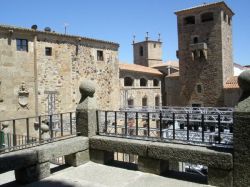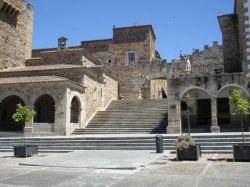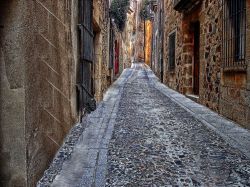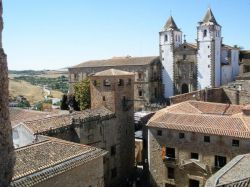Common description
In the west of Spain, near the border with Portugal, has long been one of the most interesting cities in the country, included in the UNESCO list of "Human Property" - Cáceres. It covers an area of one thousand seven hundred and sixty-eight kilometers. The population is 95802 people.
The city was recaptured in 1225 by Alfonso IX from the Moors, after which it began to settle rich merchants and aristocrats. Competing families built beautiful houses, one more beautiful than the other. Most of them were demolished in 1476 by order of Ferdinand and Isabella, who sought to end the feudal strife of Spain. Modern, more modest, appearance of the city acquired in the XV - XVI centuries, during the economic decline. The wars of the XIX - XX centuries bypassed Caceres, its historic part in 1986 was included in the UNESCO World Heritage List, now it is of growing interest to tourists, in connection with which the city itself began to develop.
The main attraction - the old town or, as they say here, the city of monuments. It really consists of some architectural monuments - within the city walls there is no new house: solid houses and churches of the XIII-XVII centuries. In the city museum at the top of the old town, in addition to the usual local lore exhibits, hang works by El Greco, Picasso and Miro. The ideal view of the city - from the hill behind the river north of the historic center.
Filled with the aroma of the past, the Old Quarter of the city of Cáceres, where side by side the architectural treasures of different times and styles, justifiably attracts the attention of tourists.
The core of the historical part of Cáceres is Plaza Mayor, where stands the main religious monument of the city - the colorful church of Santa Maria, in the appearance of which harmoniously merged features of the Gothic and Renaissance.
Opposite the Church of Santa Maria, also on the Plaza Mayor is the majestic Episcopal Palace, as well as the ancient mansion of the Casa de los Golfines de Abajo, in the XVI century belonged to one of the noble families of Cáceres.
You can get out of Plaza Mayor through the low arch of the Arco de la Estrella, next to which rises the Watchtower.
In general, the labyrinth of medieval streets of Cáceres is decorated with more than 30 city towers, each of which carries a piece of Moorish art, because they flew into the sky during the Arab rule. Among the above number of towers of Cáceres, a special article and exterior stand out Torre del Buchaco and Torre de Carvajal, which is a remarkable ensemble with the mansion of Casa de Carvajal.
Walking through the narrow and therefore shady streets of the historic quarter of Cáceres, tourists will be able to capture on film the oldest monument of the city - crowned with a stork tower mansion Casa i Torre de la Siguenya, where the military department is now located.
Another interesting mansion of Cáceres, namely the Casa de las Veletas, houses the Regional Museum, whose exhibition consists of archaeological finds in the region and various works of art.
The oldest religious building in Cáceres is the Church of Iglesia de San Mateo, built in the 14th and 17th centuries, and the most symbolic building in the city is the Royal Monastery of Santa Maria de Guadalupe, which was designed to reflect two important events in Spanish history in 1492: the Spanish victory. Arabs and the discovery of America by Columbus.
By the way, the Royal Monastery of Santa Maria de Guadalupe is not the only institution of its kind in Cáceres, in the historic quarter of which is the Convent de San Pablo, where there is a shop where monks sell homemade cakes.
Recently, the restored white-walled Jewish quarter of Cáceres - San Antonio, which got its name from the proximity to the chapel of the same name, was again filled with visitors.
The city was recaptured in 1225 by Alfonso IX from the Moors, after which it began to settle rich merchants and aristocrats. Competing families built beautiful houses, one more beautiful than the other. Most of them were demolished in 1476 by order of Ferdinand and Isabella, who sought to end the feudal strife of Spain. Modern, more modest, appearance of the city acquired in the XV - XVI centuries, during the economic decline. The wars of the XIX - XX centuries bypassed Caceres, its historic part in 1986 was included in the UNESCO World Heritage List, now it is of growing interest to tourists, in connection with which the city itself began to develop.
The main attraction - the old town or, as they say here, the city of monuments. It really consists of some architectural monuments - within the city walls there is no new house: solid houses and churches of the XIII-XVII centuries. In the city museum at the top of the old town, in addition to the usual local lore exhibits, hang works by El Greco, Picasso and Miro. The ideal view of the city - from the hill behind the river north of the historic center.
Filled with the aroma of the past, the Old Quarter of the city of Cáceres, where side by side the architectural treasures of different times and styles, justifiably attracts the attention of tourists.
The core of the historical part of Cáceres is Plaza Mayor, where stands the main religious monument of the city - the colorful church of Santa Maria, in the appearance of which harmoniously merged features of the Gothic and Renaissance.
Opposite the Church of Santa Maria, also on the Plaza Mayor is the majestic Episcopal Palace, as well as the ancient mansion of the Casa de los Golfines de Abajo, in the XVI century belonged to one of the noble families of Cáceres.
You can get out of Plaza Mayor through the low arch of the Arco de la Estrella, next to which rises the Watchtower.
In general, the labyrinth of medieval streets of Cáceres is decorated with more than 30 city towers, each of which carries a piece of Moorish art, because they flew into the sky during the Arab rule. Among the above number of towers of Cáceres, a special article and exterior stand out Torre del Buchaco and Torre de Carvajal, which is a remarkable ensemble with the mansion of Casa de Carvajal.
Walking through the narrow and therefore shady streets of the historic quarter of Cáceres, tourists will be able to capture on film the oldest monument of the city - crowned with a stork tower mansion Casa i Torre de la Siguenya, where the military department is now located.
Another interesting mansion of Cáceres, namely the Casa de las Veletas, houses the Regional Museum, whose exhibition consists of archaeological finds in the region and various works of art.
The oldest religious building in Cáceres is the Church of Iglesia de San Mateo, built in the 14th and 17th centuries, and the most symbolic building in the city is the Royal Monastery of Santa Maria de Guadalupe, which was designed to reflect two important events in Spanish history in 1492: the Spanish victory. Arabs and the discovery of America by Columbus.
By the way, the Royal Monastery of Santa Maria de Guadalupe is not the only institution of its kind in Cáceres, in the historic quarter of which is the Convent de San Pablo, where there is a shop where monks sell homemade cakes.
Recently, the restored white-walled Jewish quarter of Cáceres - San Antonio, which got its name from the proximity to the chapel of the same name, was again filled with visitors.
Caceres on map
+ 15°C








